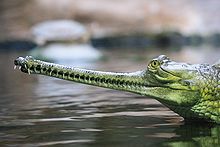
Back جافياليات الشكل Arabic جافياليات الشكل ARZ Qavialkimilər Azerbaijani Gavialoidea Spanish Gavialoidea Basque تمساحواران پوزهباریک Persian Gavialoidea French Gavialoidea Galician Gavialoidea Italian インドガビアル上科 Japanese
| Gavialoidea Temporal range: Possible Cenomanian origin, if "thoracosaurs" are included[1]
| |
|---|---|

| |
| Indian gharial, Gavialis gangeticus | |
| Scientific classification | |
| Domain: | Eukaryota |
| Kingdom: | Animalia |
| Phylum: | Chordata |
| Class: | Reptilia |
| Clade: | Archosauromorpha |
| Clade: | Archosauriformes |
| Order: | Crocodilia |
| Clade: | Longirostres |
| Superfamily: | Gavialoidea Hay, 1930 |
| Subgroups | |
| |
Gavialoidea is one of three superfamilies of crocodylians, the other two being Alligatoroidea and Crocodyloidea. Although many extinct species are known, only the gharial Gavialis gangeticus and the false gharial Tomistoma schlegelii are alive today, with Hanyusuchus having become extinct in the last few centuries.
Extinct South American gavialoids likely dispersed in the mid Tertiary from Africa and Asia.[4] Fossil remains of the Puerto Rican gavialoid Aktiogavialis puertorisensis were discovered in a cave located in San Sebastián, Puerto Rico and dated to the Oligocene. This individual is thought to have crossed the Atlantic coming from Africa, indicating that this species was able to withstand saltwater.[5]
- ^ a b Cite error: The named reference
PP23was invoked but never defined (see the help page). - ^ Jouve, S.; de Muizon, C.; Cespedes-Paz, R.; Sossa-Soruco, V.; Knoll, S. (2020). "The longirostrine crocodyliforms from Bolivia and their evolution through the Cretaceous–Palaeogene boundary". Zoological Journal of the Linnean Society. 192 (2): 475–509. doi:10.1093/zoolinnean/zlaa081.
- ^ Jouve, Stéphane; Bardet, Nathalie; Jalil, Nour-Eddine; Suberbiola, Xabier Pereda; Bouya; Baâda; Amaghzaz, Mbarek (2008). "The oldest African crocodylian: phylogeny, paleobiogeography, and differential survivorship of marine reptiles through the Cretaceous-Tertiary Boundary" (PDF). Journal of Vertebrate Paleontology. 28 (2): 409–421. doi:10.1671/0272-4634(2008)28[409:TOACPP]2.0.CO;2.
- ^ Brochu, C. A. (2003). "Phylogenetic approaches toward crocodylian history". Annual Review of Earth and Planetary Sciences. 31 (31): 357–397. Bibcode:2003AREPS..31..357B. doi:10.1146/annurev.earth.31.100901.141308.
- ^ Vélez-Juarbe, J.; Brochu, C. A. & Santos, H. (2007). "A gharial from the Oligocene of Puerto Rico: transoceanic dispersal in the history of a non-marine reptile". Proceedings of the Royal Society. 274 (1615): 1245–1254. doi:10.1098/rspb.2006.0455. PMC 2176176. PMID 17341454.